Heavy Metal Detection in Fritillaria thunbergii Using Laser-Induced Breakdown Spectroscopy Coupled with Variable Selection Algorithm and Chemometrics
Abstract
1. Introduction
2. Materials and Methods
2.1. Sample Collection and Preparation
2.2. Experimental Setup
2.3. Determination of Heavy-Metals Reference Value
2.4. Data Analysis
2.4.1. Spectral Modeling
2.4.2. Variable Selection Methods
2.4.3. Model Evaluation and Calculation
3. Results and Discussion
3.1. Spectra Analysis
3.2. Heavy Metals Prediction Using Full and Selected Variables
3.2.1. Cd Content Prediction Using Full and Selected Variables
3.2.2. Cu Content Prediction Using Full and Selected Variables
3.2.3. Pb Content Prediction Using Full and Selected Variables
4. Discussion
5. Conclusions
Author Contributions
Funding
Data Availability Statement
Acknowledgments
Conflicts of Interest
References
- Jiang, Y.; Kang, J.; Wang, Y.; Chen, Y.; Li, R. Rapid and sensitive analysis of trace leads in medicinal herbs using laser-lnduced breakdown spectroscopy-laser-induced fluorescence (libs-lif). Appl. Spectrosc. 2019, 73, 1284–1291. [Google Scholar] [PubMed]
- Gyamfi, E.T. Metals and metalloids in traditional medicines (ayurvedic medicines, nutraceuticals and traditional chinese medicines). Environ. Sci. Pollut. Res. Int. 2019, 26, 15767–15778. [Google Scholar] [CrossRef] [PubMed]
- Dudka, S.; Miller, W.P. Accumulation of potentially toxic elements in plants and their transfer to human food chain. J. Environ. Sci. Health Part B 1999, 34, 681–708. [Google Scholar] [CrossRef] [PubMed]
- Dube, A.; Zbytniewski, R.; Kowalkowski, T.; Cukrowska, E.; Buszewski, B. Adsorption and migration of heavy metals in soil. Pol. J. Environ. Stud. 2001, 10, 1–10. [Google Scholar]
- Ercal, N.; Gurer-Orhan, H.; Aykin-Burns, N. Toxic metals and oxidative stress part i: Mechanisms involved in metal-induced oxidative damage. Curr. Top Med. Chem. 2001, 1, 529–539. [Google Scholar] [CrossRef]
- Duruibe, J.; Ogwuegbu, M.O.C.; Egwurugwu, J. Heavy metal pollution and human biotoxic effects. Int. J. Phys. Sci. 2007, 2, 112–118. [Google Scholar]
- Wei, B.; Yang, L. A review of heavy metal contaminations in urban soils, urban road dusts and agricultural soils from china. Microchem. J. 2010, 94, 99–107. [Google Scholar] [CrossRef]
- Orecchio, S.; Amorello, D.; Barreca, S.; Valenti, A. Wood pellets for home heating can be considered environmentally friendly fuels? polycyclic aromatic hydrocarbons (pahs) in their ashes. Microchem. J. 2016, 124, 267–271. [Google Scholar] [CrossRef]
- Tang, Y.; Wang, X.; Jia, J. Mercury poisoning presenting as sporadic creutzfeldt-jakob disease: A case report. Ann. Intern. Med. 2015, 162, 462–463. [Google Scholar] [CrossRef]
- Chan, N.C.N.; Chan, K.P. Coarse basophilic stippling in lead poisoning. Blood 2017, 129, 3270. [Google Scholar] [CrossRef]
- Hao, D.-C.; Gu, X.-J.; Xiao, P.-G.; Peng, Y. Phytochemical and biological research of fritillaria medicine resources. Chin. J. Nat. Med. 2013, 11, 330–344. [Google Scholar] [CrossRef]
- Hill, C.B.; Roessner, U. Metabolic Profiling of Plants by GC–MS. In The Handbook of Plant Metabolomics; John Wiley & Sons: Hoboken, NJ, USA, 2013. [Google Scholar]
- Ju, W. Clinical observation on effects of adjuvant chemotherapy with fritillary thunbergii bulb complex granules on symptoms of refractory acute leukemia patients. Beijing J. Tradit. Chin. Med. 2013, 32, 833–835. [Google Scholar]
- Tian, M.; Fang, L.; Yan, X.; Xiao, W.; Row, K.H. Determination of heavy metal ions and organic pollutants in water samples using ionic liquids and ionic liquid-modified sorbents. J. Anal. Methods Chem. 2019, 2019, 1948965. [Google Scholar] [CrossRef]
- Yin, H.; Truskewycz, A.; Cole, I. Quantum dot (qd)-based probes for multiplexed determination of heavy metal ions. Microchim. Acta 2020, 187, 336. [Google Scholar] [CrossRef]
- Fu, F.; Wang, Q. Removal of heavy metal ions from wastewaters: A review. J. Environ. Manag. 2011, 92, 407–418. [Google Scholar] [CrossRef]
- Fortes, F.J.; Moros, J.; Lucena, P.; Cabalín, L.M.; Laserna, J.J. Laser-induced breakdown spectroscopy. Anal. Chem. 2013, 85, 640–669. [Google Scholar] [CrossRef]
- Kim, G.; Kwak, J.; Kim, K.-R.; Lee, H.; Kim, K.-W.; Yang, H.; Park, K. Rapid detection of soils contaminated with heavy metals and oils by laser induced breakdown spectroscopy (libs). J. Hazard. Mater. 2013, 263, 754–760. [Google Scholar] [CrossRef]
- Sawan, S.; Maalouf, R.; Errachid, A.; Jaffrezic-Renault, N. Metal and metal oxide nanoparticles in the voltammetric detection of heavy metals: A review. TrAC Trends Anal. Chem. 2020, 131, 116014. [Google Scholar] [CrossRef]
- Malik, L.A.; Bashir, A.; Qureashi, A.; Pandith, A.H. Detection and removal of heavy metal ions: A review. Environ. Chem. Lett. 2019, 17, 1495–1521. [Google Scholar] [CrossRef]
- Amorello, D.; Barreca, S.; Gulli, E.; Orecchio, S. Platinum and rhodium in wine samples by using voltammetric techniques. Microchem. J. 2017, 130, 229–235. [Google Scholar] [CrossRef]
- Rai, N.K.; Rai, A.K. Libs—An efficient approach for the determination of cr in industrial wastewater. J. Hazard. Mater. 2008, 150, 835–838. [Google Scholar] [CrossRef] [PubMed]
- Gondal, M.; Seddigi, Z.; Nasr, M.; Gondal, B. Spectroscopic detection of health hazardous contaminants in lipstick using laser induced breakdown spectroscopy. J. Hazard. Mater. 2010, 175, 726–732. [Google Scholar] [CrossRef]
- Hahn, D.W.; Omenetto, N. Laser-induced breakdown spectroscopy (libs), part i: Review of basic diagnostics and plasma–particle interactions: Still-challenging issues within the analytical plasma community. Appl. Spectrosc. 2010, 64, 335A–366A. [Google Scholar] [CrossRef] [PubMed]
- Ma, S.; Tang, Y.; Ma, Y.; Chu, Y.; Chen, F.; Hu, Z.; Zhu, Z.; Guo, L.; Zeng, X.; Lu, Y. Determination of trace heavy metal elements in aqueous solution using surface-enhanced laser-induced breakdown spectroscopy. Opt. Express 2019, 27, 15091–15099. [Google Scholar] [CrossRef] [PubMed]
- Ma, S.; Tang, Y.; Ma, Y.; Dong, D.; Guo, L.; Zhu, H.; Liu, J.; Lu, Y. The pH effect on the detection of heavy metals in wastewater by laser-induced breakdown spectroscopy coupled with a phase transformation method. J. Anal. At. Spectrom. 2020, 35, 198–203. [Google Scholar] [CrossRef]
- Hahn, D.W.; Omenetto, N. Laser-induced breakdown spectroscopy (libs), part ii: Review of instrumental and methodological approaches to material analysis and applications to different fields. Appl. Spectrosc. 2012, 66, 347–419. [Google Scholar] [CrossRef]
- Noll, R.; Fricke-Begemann, C.; Connemann, S.; Meinhardt, C.; Sturm, V. Libs analyses for industrial applications—An overview of developments from 2014 to 2018. J. Anal. At. Spectrom. 2018, 33, 945–956. [Google Scholar] [CrossRef]
- Zou, X.H.; Guo, L.B.; Shen, M.; Li, X.Y.; Hao, Z.Q.; Zeng, Q.D.; Lu, Y.F.; Wang, Z.M.; Zeng, X.Y. Accuracy improvement of quantitative analysis in laser-induced breakdown spectroscopy using modified wavelet transform. Opt. Express 2014, 22, 10233–10238. [Google Scholar] [CrossRef]
- Gondal, M.A.; Siddiqui, M.N. Identification of different kinds of plastics using laser-induced breakdown spectroscopy for waste management. J. Environ. Sci. Health Part A 2007, 42, 1989–1997. [Google Scholar] [CrossRef]
- Unnikrishnan, V.K.; Choudhari, K.S.; Kulkarni, S.D.; Nayak, R.; Kartha, V.B.; Santhosh, C.; Suri, B.M. Biomedical and environmental applicationsof laser-induced breakdown spectroscopy. Pramana 2014, 82, 397–401. [Google Scholar] [CrossRef]
- Ahmed, I.; Yang, J.; Law, A.W.L.; Manno, F.A.M.; Ahmed, R.; Zhang, Y.; Lau, C. Rapid and in situ optical detection of trace lithium in tissues. Biomed. Opt. Express 2018, 9, 4459–4471. [Google Scholar] [CrossRef]
- Tang, S.S.; Hao, Z.Q.; Ma, Y.Y.; Ma, S.X.; Guo, L.B.; Guo, Y.M.; Zeng, X.Y.; Chu, Y.W.; Lu, Y.F. Accuracy and stability improvement for meat species identification using multiplicative scatter correction and laser-induced breakdown spectroscopy. Opt. Express 2018, 26, 10119. [Google Scholar]
- Pandhija, S.; Rai, N.K.; Rai, A.K.; Thakur, S.N. Contaminant concentration in environmental samples using libs and cf-libs. Appl. Phys. B 2010, 98, 231–241. [Google Scholar] [CrossRef]
- Gondal, M.A.; Hussain, T.; Yamani, Z.H.; Baig, M.A. On-line monitoring of remediation process of chromium polluted soil using libs. J. Hazard. Mater. 2009, 163, 1265–1271. [Google Scholar] [CrossRef]
- Wang, W.; Kong, W.; Shen, T.; Man, Z.; Zhu, W.; He, Y.; Liu, F.; Liu, Y. Application of laser-induced breakdown spectroscopy in detection of cadmium content in rice stems. Front. Plant Sci. 2020, 11, 599616. [Google Scholar] [CrossRef]
- Su, L.; Shi, W.; Chen, X.; Meng, L.; Yuan, L.; Chen, X.; Huang, G. Simultaneously and quantitatively analyze the heavy metals in Sargassum fusiforme by laser-induced breakdown spectroscopy. Food Chem. 2021, 338, 127797. [Google Scholar] [CrossRef]
- Liu, Y.; Chu, Y.; Hu, Z.; Zhang, S.; Ma, S.; Khan, M.S.; Chen, F.; Zhang, D.; Guo, L.; Lau, C. High-sensitivity determination of trace lead and cadmium in cosmetics using laser-induced breakdown spectroscopy with ultrasound-assisted extraction. Microchem. J. 2020, 158, 105322. [Google Scholar] [CrossRef]
- Rehan, I.; Gondal, M.A.; Rehan, K.; Sultana, S.; Dastageer, M.A.; Al-Adel, F.F. Libs for the detection of lead in ready to use henna paste and nutrients in fresh henna leaves and cultivated soils. Talanta 2019, 199, 203–211. [Google Scholar] [CrossRef]
- Wang, J.; Xue, S.; Zheng, P.; Chen, Y.; Peng, R. Determination of lead and copper in ligusticum wallichii by laser-induced breakdown spectroscopy. Anal. Lett. 2017, 50, 2000–2011. [Google Scholar] [CrossRef]
- Zhao, S.; Song, C.; Gao, X.; Lin, J. Quantitative analysis of pb in soil by femtosecond-nanosecond double-pulse laser-induced breakdown spectroscopy. Results Phys. 2019, 15, 102736. [Google Scholar] [CrossRef]
- Zhu, C.; Lv, J.; Liu, K.; Chen, J.; Liu, K.; Li, G.; Lu, B.; Li, X. Rapid determination of arsenic in traditional chinese medicine by laser-induced breakdown spectroscopy (libs). Anal. Lett. 2022, 55, 2531–2541. [Google Scholar] [CrossRef]
- Rehan, I.; Gondal, M.A.; Rehan, K.; Sultana, S. Spectral diagnosis of health hazardous toxins in face foundation powders using laser induced breakdown spectroscopy and inductively coupled plasma-optical emission spectroscopy (icp-oes). Talanta 2020, 217, 121007. [Google Scholar] [CrossRef] [PubMed]
- Zhu, C.; Tang, Z.; Li, Q.; Zhou, R.; Lv, J.; Zhang, W.; Zhan, K.; Li, X.; Zeng, X. Lead of detection in rhododendron leaves using laser-induced breakdown spectroscopy assisted by laser-induced fluorescence. Sci. Total Environ. 2020, 738, 139402. [Google Scholar] [CrossRef] [PubMed]
- Peng, J.; He, Y.; Jiang, J.; Zhao, Z.; Zhou, F.; Liu, F. High-accuracy and fast determination of chromium content in rice leaves based on collinear dual-pulse laser-induced breakdown spectroscopy and chemometric methods. Food Chem. 2019, 295, 327–333. [Google Scholar] [CrossRef] [PubMed]
- Yang, P.; Zhou, R.; Zhang, W.; Yi, R.; Tang, S.; Guo, L.; Hao, Z.; Li, X.; Lu, Y.; Zeng, X. High-sensitivity determination of cadmium and lead in rice using laser-induced breakdown spectroscopy. Food Chem. 2019, 272, 323–328. [Google Scholar] [CrossRef] [PubMed]
- Li, K.; Yang, H.; Yuan, X.; Zhang, M. Recent developments of heavy metals detection in traditional chinese medicine by atomic spectrometry. Microchem. J. 2021, 160, 105726. [Google Scholar] [CrossRef]
- Liu, F.; Ye, L.; Peng, J.; Song, K.; Shen, T.; Zhang, C.; He, Y. Fast detection of copper content in rice by laser-induced breakdown spectroscopy with uni-and multivariate analysis. Sensors 2018, 18, 705. [Google Scholar] [CrossRef]
- Kabir, M.H.; Guindo, M.L.; Chen, R.; Sanaeifar, A.; Liu, F. Application of laser-induced breakdown spectroscopy and chemometrics for the quality evaluation of foods with medicinal properties: A review. Foods 2022, 11, 2051. [Google Scholar] [CrossRef]
- Huffman, C.; Sobral, H.; Terán-Hinojosa, E. Laser-induced breakdown spectroscopy spectral feature selection to enhance classification capabilities: A t-test filter approach. Spectrochim. Acta Part B At. Spectrosc. 2019, 162, 105721. [Google Scholar] [CrossRef]
- Gholizadeh, A.; Žižala, D.; Saberioon, M.; Borůvka, L. Soil organic carbon and texture retrieving and mapping using proximal, airborne and Sentinel-2 spectral imaging. Remote Sens. Environ. 2018, 218, 89–103. [Google Scholar] [CrossRef]
- Guindo, M.L.; Kabir, M.H.; Chen, R.; Liu, F. Particle swarm optimization and multiple stacked generalizations to detect nitrogen and organic-matter in organic-fertilizer using vis-nir. Sensors 2021, 21, 4882. [Google Scholar] [CrossRef]
- Douglas, R.K.; Nawar, S.; Cipullo, S.; Alamar, M.C.; Coulon, F.; Mouazen, A.M. Evaluation of vis-nir reflectance spectroscopy sensitivity to weathering for enhanced assessment of oil contaminated soils. Sci. Total Environ. 2018, 626, 1108–1120. [Google Scholar] [CrossRef]
- Shi, T.; Chen, Y.; Liu, H.; Wang, J.; Wu, G. Soil organic carbon content estimation with laboratory-based visible-near-infrared reflectance spectroscopy: Feature selection. Appl. Spectrosc. 2014, 68, 831–837. [Google Scholar] [CrossRef]
- Rossel, R.A.V.; Behrens, T. Using data mining to model and interpret soil diffuse reflectance spectra. Geoderma 2010, 158, 46–54. [Google Scholar] [CrossRef]
- Xiaobo, Z.; Jiewen, Z.; Povey, M.J.W.; Holmes, M.; Hanpin, M. Variables selection methods in near-infrared spectroscopy. Anal. Chim. Acta 2010, 667, 14–32. [Google Scholar] [CrossRef]
- Li, H.; Liang, Y.; Xu, Q.; Cao, D. Key wavelengths screening using competitive adaptive reweighted sampling method for multivariate calibration. Anal. Chim. Acta 2009, 648, 77–84. [Google Scholar] [CrossRef]
- Vohland, M.; Ludwig, M.; Thiele-Bruhn, S.; Ludwig, B. Determination of soil properties with visible to near- and mid-infrared spectroscopy: Effects of spectral variable selection. Geoderma 2014, 223–225, 88–96. [Google Scholar] [CrossRef]
- Wang, S.-L.; Li, J.; Fang, J. Predicting progression of als disease with random frog and support vector regression method. In Intelligent Computing Methodologies; Springer International Publishing: Cham, Switzerland, 2016; pp. 160–170. [Google Scholar]
- Pan, L.; Lu, R.; Zhu, Q.; Tu, K.; Cen, H. Predict compositions and mechanical properties of sugar beet using hyperspectral scattering. Food Bioprocess Technol. 2016, 9, 1177–1186. [Google Scholar] [CrossRef]
- Dong, J.; Guo, W.; Wang, Z.; Liu, D.; Zhao, F. Nondestructive determination of soluble solids content of ‘fuji’ apples produced in different areas and bagged with different materials during ripening. Food Anal. Methods 2016, 9, 1087–1095. [Google Scholar] [CrossRef]
- Guindo, M.L.; Kabir, M.H.; Chen, R.; Liu, F. Potential of vis-nir to measure heavy metals in different varieties of organic-fertilizers using boruta and deep belief network. Ecotoxicol. Env. Saf. 2021, 228, 112996. [Google Scholar] [CrossRef]
- Shen, T.; Kong, W.; Liu, F.; Chen, Z.; Yao, J.; Wang, W.; Peng, J.; Chen, H.; He, Y. Rapid determination of cadmium contamination in lettuce using laser-induced breakdown spectroscopy. Molecules 2018, 23, 2930. [Google Scholar] [CrossRef] [PubMed]
- Tawfik, W.; Askar, A. Study of the matrix effect on the plasma characterization of heavy elements in soil sediments. Prog. Phys. 2007, 3, 46–52. [Google Scholar]
- El Haddad, J.; Canioni, L.; Bousquet, B. Good practices in libs analysis: Review and advices. Spectrochim. Acta Part B At. Spectrosc. 2014, 101, 171–182. [Google Scholar] [CrossRef]
- Zhang, T.; Wu, S.; Dong, J.; Wei, J.; Wang, K.; Tang, H.; Yang, X.; Li, H. Quantitative and classification analysis of slag samples by laser induced breakdown spectroscopy (libs) coupled with support vector machine (svm) and partial least square (pls) methods. J. Anal. At. Spectrom. 2015, 30, 368–374. [Google Scholar] [CrossRef]
- Yan, C.; Qi, J.; Ma, J.; Tang, H.; Zhang, T.; Li, H. Determination of carbon and sulfur content in coal by laser induced breakdown spectroscopy combined with kernel-based extreme learning machine. Chemom. Intell. Lab. Syst. 2017, 167, 226–231. [Google Scholar] [CrossRef]
- Pořízka, P.; Klus, J.; Hrdlička, A.; Vrábel, J.; Škarková, P.; Prochazka, D.; Novotný, J.; Novotný, K.; Kaiser, J. Impact of laser-induced breakdown spectroscopy data normalization on multivariate classification accuracy. J. Anal. At. Spectrom. 2017, 32, 277–288. [Google Scholar] [CrossRef]
- Myakalwar, A.K.; Spegazzini, N.; Zhang, C.; Anubham, S.K.; Dasari, R.R.; Barman, I.; Gundawar, M.K. Less is more: Avoiding the libs dimensionality curse through judicious feature selection for explosive detection. Sci. Rep. 2015, 5, 13169. [Google Scholar] [CrossRef]
- Wang, Q.; Teng, G.; Qiao, X.; Zhao, Y.; Kong, J.; Dong, L.; Cui, X. Importance evaluation of spectral lines in laser-induced breakdown spectroscopy for classification of pathogenic bacteria. Biomed. Opt. Express 2018, 9, 5837–5850. [Google Scholar] [CrossRef]
- Menze, B.H.; Kelm, B.M.; Masuch, R.; Himmelreich, U.; Bachert, P.; Petrich, W.; Hamprecht, F.A. A comparison of random forest and its gini importance with standard chemometric methods for the feature selection and classification of spectral data. BMC Bioinform. 2009, 10, 213. [Google Scholar] [CrossRef]
- Duan, F.; Fu, X.; Jiang, J.; Huang, T.; Ma, L.; Zhang, C. Automatic variable selection method and a comparison for quantitative analysis in laser-induced breakdown spectroscopy. Spectrochim. Acta Part B At. Spectrosc. 2018, 143, 12–17. [Google Scholar] [CrossRef]
- Zhang, C.; Wang, Q.; Liu, F.; He, Y.; Xiao, Y. Rapid and non-destructive measurement of spinach pigments content during storage using hyperspectral imaging with chemometrics. Measurement 2017, 97, 149–155. [Google Scholar] [CrossRef]
- Sun, D.; Yang, F.; Su, M.; Han, W.; Dong, C. Quantitative analysis of cu in traditional chinese medicinal materials using laser-induced breakdown spectroscopy. Microw. Opt. Technol. Lett. 2022. [Google Scholar] [CrossRef]
- Zhu, C.; Lv, J.; Liu, K.; Li, Q.; Tang, Z.; Zhou, R.; Zhang, W.; Chen, J.; Liu, K.; Li, X. Fast detection of harmful trace elements in glycyrrhiza using standard addition and internal standard method–Laser-induced breakdown spectroscopy (sais-libs). Microchem. J. 2021, 168, 106408. [Google Scholar] [CrossRef]
- Liu, F.; Shen, T.; Kong, W.; Peng, J.; Zhang, C.; Song, K.; Wang, W.; Zhang, C.; He, Y. Quantitative analysis of cadmium in tobacco roots using laser-induced breakdown spectroscopy with variable index and chemometrics. Front. Plant Sci. 2018, 9, 1316. [Google Scholar] [CrossRef]
- Gondal, M.A.; Nasr, M.M.; Ahmed, M.M.; Yamani, Z.H.; Alsalhi, M. Detection of lead in paint samples synthesized locally using-laser-induced breakdown spectroscopy. J. Environ. Sci. Health Part A 2011, 46, 42–49. [Google Scholar] [CrossRef]
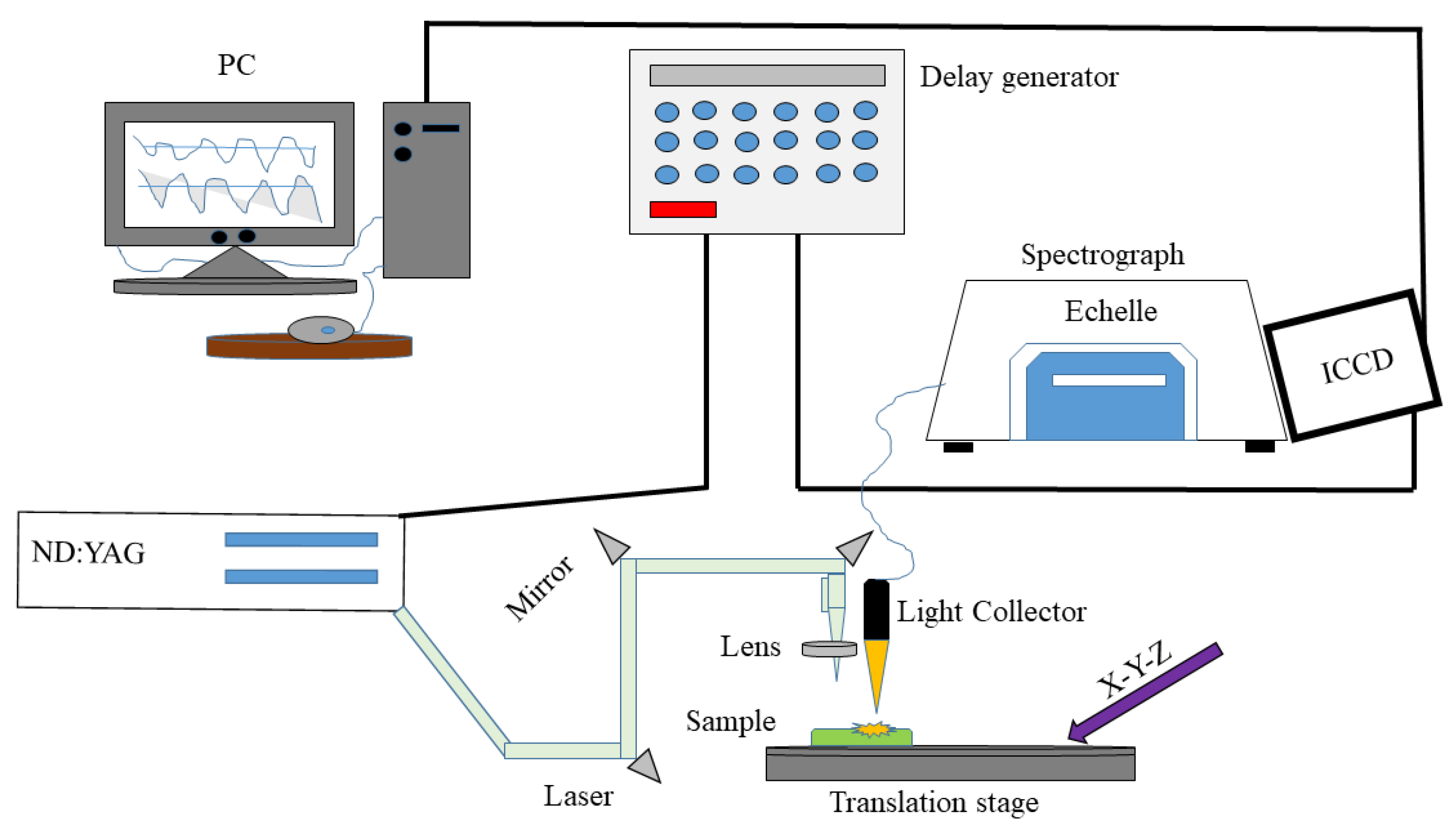
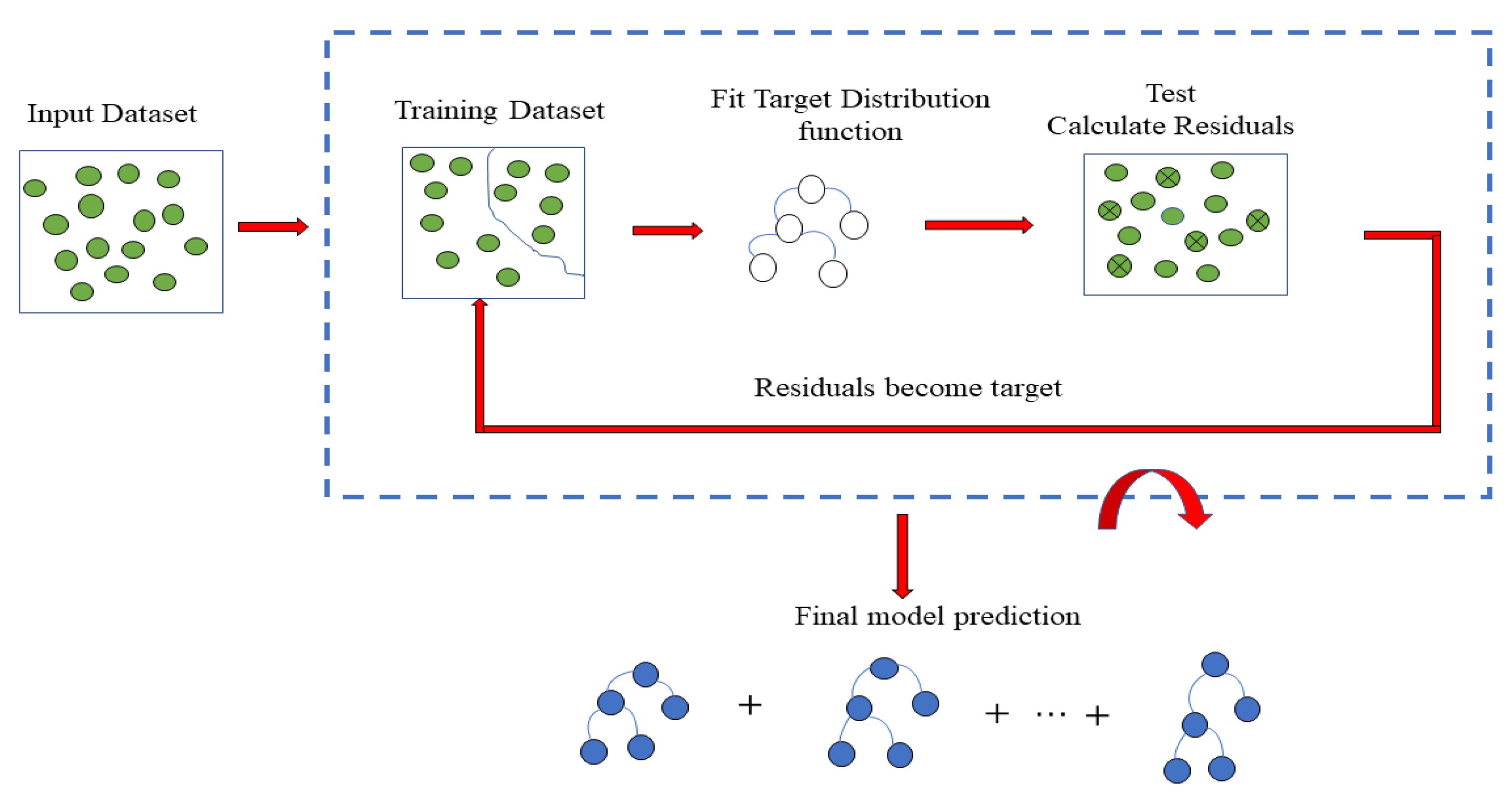
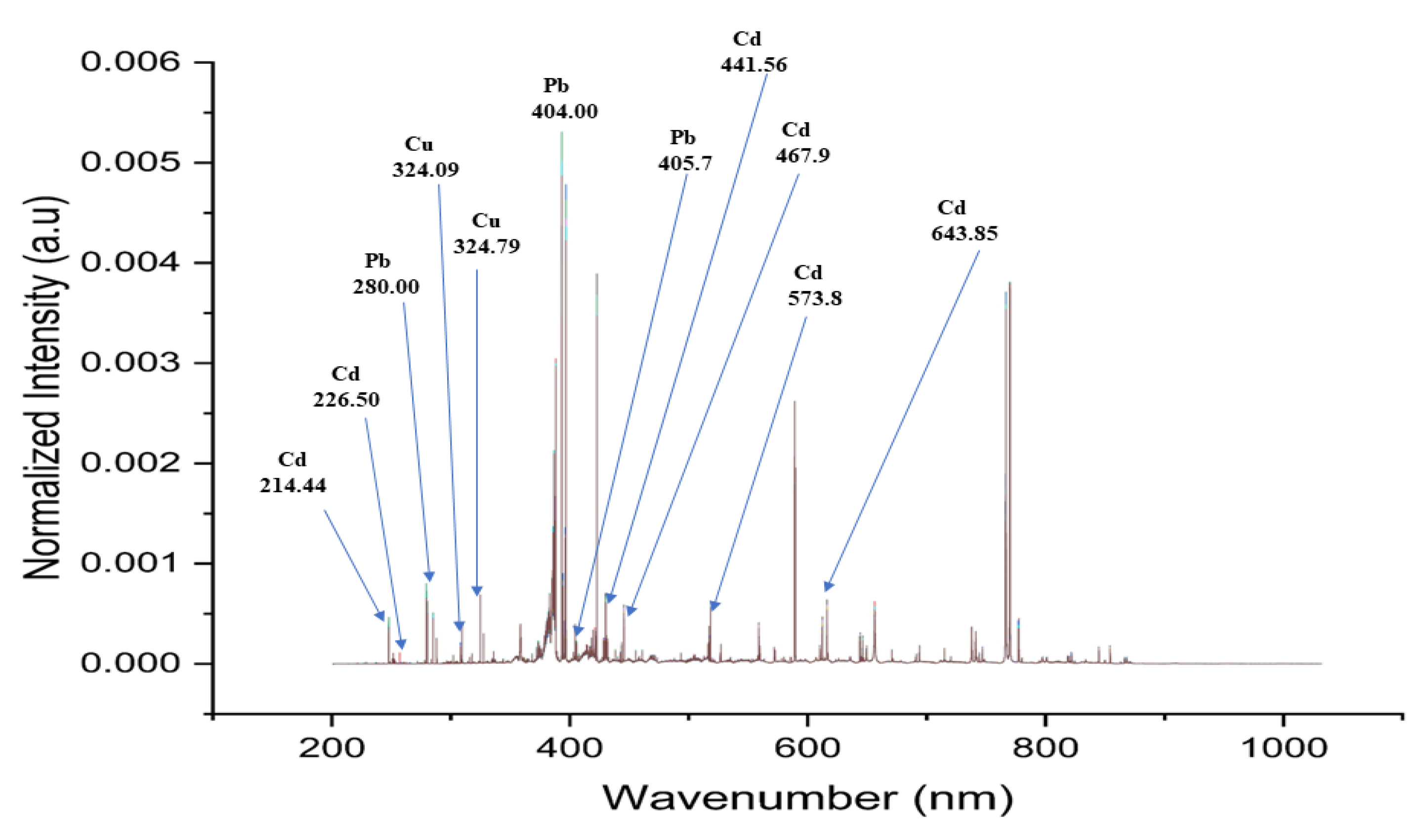

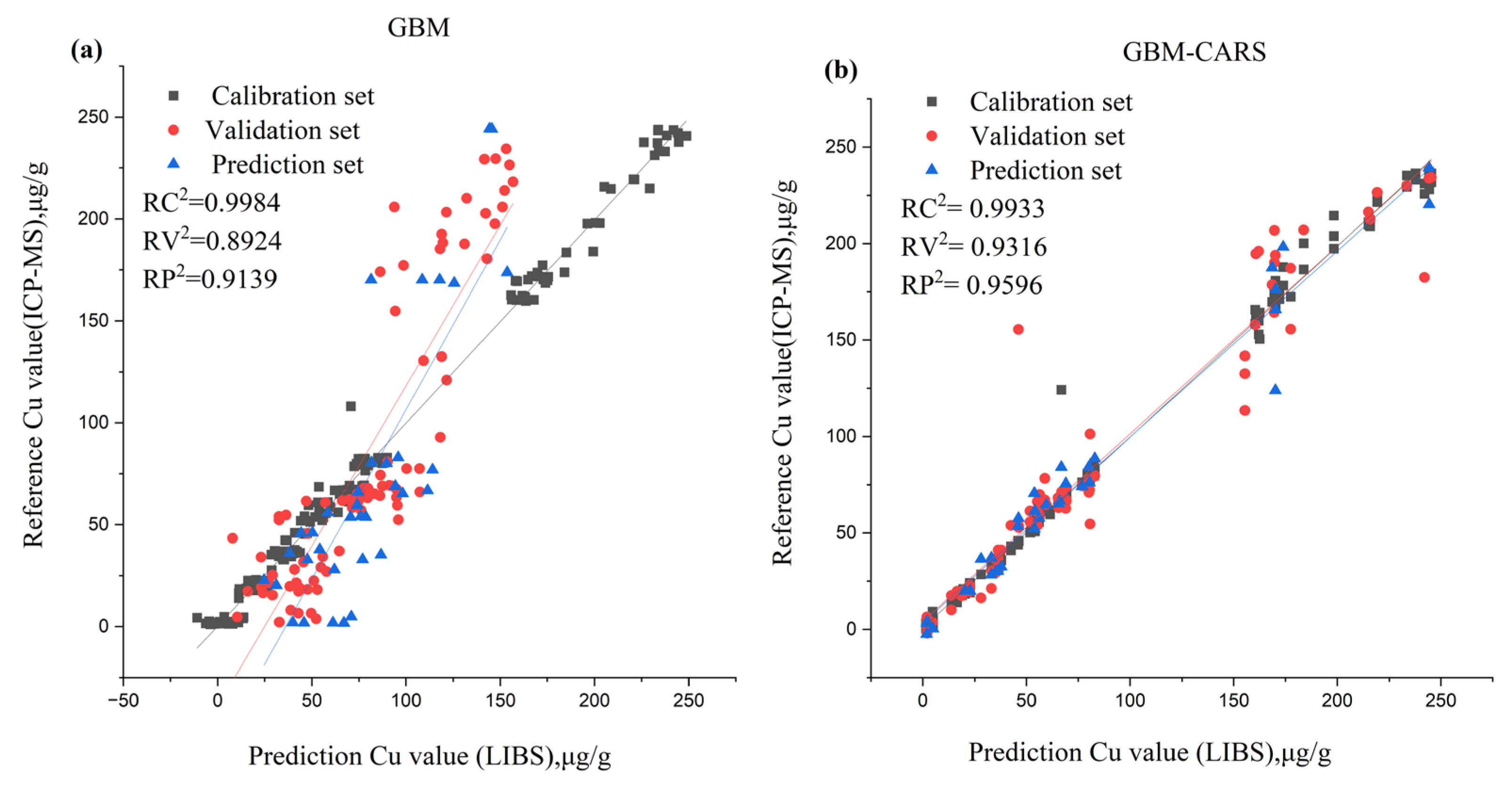
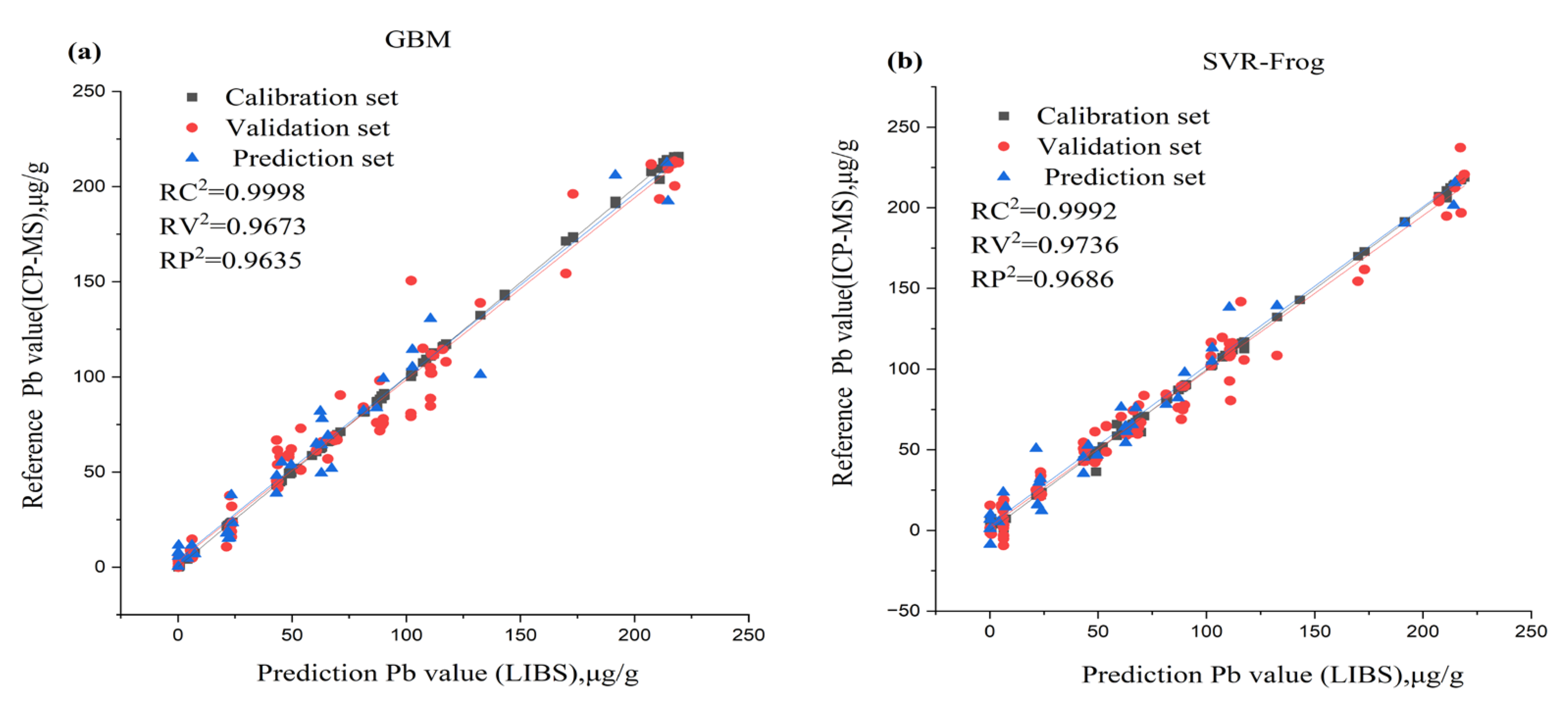

| Heavy Metal | Groups | CK | 1 | 2 | 3 | 4 | 5 | 6 | 7 |
|---|---|---|---|---|---|---|---|---|---|
| Number | 36 | 36 | 36 | 36 | 36 | 36 | 36 | 36 | |
| Cu | Min. | 1.50 | 13.80 | 33.01 | 42.51 | 53.76 | 66.49 | 155.41 | 169.66 |
| Max. | 4.88 | 27.99 | 55.97 | 61.28 | 69.33 | 82.97 | 242.04 | 245.36 | |
| Mean | 2.50 | 20.06 | 37.31 | 52.48 | 65.95 | 79.66 | 172.57 | 215.06 | |
| Range | 3.37 | 14.18 | 22.95 | 18.76 | 15.57 | 16.47 | 86.63 | 75.69 | |
| Var. | 1.20 | 13.14 | 36.71 | 37.67 | 16.87 | 20.33 | 517.21 | 773.97 | |
| Std | 1.09 | 3.62 | 6.05 | 6.13 | 4.10 | 4.50 | 22.74 | 27.82 | |
| Cd | Min. | 0.17 | 5.21 | 9.64 | 20.81 | 24.73 | 44.85 | 63.06 | 83.66 |
| Max. | 1.19 | 7.08 | 11.70 | 25.34 | 29.38 | 97.26 | 117.89 | 100.65 | |
| Mean | 0.43 | 5.86 | 10.64 | 22.87 | 26.39 | 60.32 | 82.48 | 93.91 | |
| Range | 1.02 | 1.87 | 2.05 | 4.52 | 4.65 | 52.41 | 54.82 | 16.98 | |
| Var. | 0.07 | 0.21 | 0.31 | 2.34 | 1.72 | 394.02 | 175.37 | 35.38 | |
| Std. | 0.28 | 0.46 | 0.56 | 1.53 | 1.31 | 19.85 | 13.24 | 5.94 | |
| Pb | Min. | 0.13 | 4.12 | 21.28 | 43.13 | 58.61 | 63.14 | 102.16 | 143.12 |
| Max. | 0.76 | 7.33 | 23.90 | 102.03 | 71.15 | 90.51 | 112.26 | 219.07 | |
| Mean | 0.29 | 6.06 | 22.75 | 51.58 | 65.62 | 85.00 | 112.26 | 199.24 | |
| Range | 0.63 | 3.21 | 2.61 | 58.90 | 12.53 | 27.36 | 30.33 | 75.95 | |
| Var. | 0.03 | 0.56 | 0.64 | 265.51 | 14.55 | 59.54 | 63.84 | 604.43 | |
| Std. | 0.19 | 0.74 | 0.80 | 16.29 | 3.81 | 7.71 | 7.99 | 24.58 |
| Models | Variables | RC2 | RMSEC | RV2 | RMSEV | RP2 | RMSEP | |
|---|---|---|---|---|---|---|---|---|
| Cd | SVR | Full variables | 0.9999 | 0.0995 | 0.8957 | 11.0874 | 0.8276 | 14.5054 |
| PLSR | Full variables | 0.9923 | 3.0637 | 0.6791 | 19.4539 | 0.5499 | 23.4405 | |
| GBM | Full variables | 0.9984 | 1.3693 | 0.8924 | 11.2625 | 0.9139 | 10.2494 | |
| Cu | SVR | Full variables | 0.9999 | 0.0995 | 0.9606 | 13.9359 | 0.9280 | 17.5096 |
| PLSR | Full variables | 0.9936 | 5.7691 | 0.6902 | 39.1138 | 0.5622 | 43.1827 | |
| GBM | Full variables | 0.9979 | 3.2885 | 0.9308 | 18.4815 | 0.9596 | 13.1156 | |
| Pb | SVR | Full variables | 0.9999 | 0.0996 | 0.9304 | 16.6308 | 0.8876 | 19.1794 |
| PLSR | Full variables | 0.9938 | 4.9443 | 0.6925 | 34.9791 | 0.6272 | 34.9311 | |
| GBM | Full variables | 0.9998 | 0.8488 | 0.9673 | 11.3933 | 0.9635 | 10.9220 |
| Elements | Methods | N | RC2 | RMSEC | RV2 | RMSEV | RP2 | RMSEP | |
|---|---|---|---|---|---|---|---|---|---|
| SVR | Cd | CARS | 37 | 0.9707 | 5.9935 | 0.9235 | 9.4984 | 0.8139 | 15.0703 |
| RF | 151 | 0.9999 | 0.1000 | 0.9287 | 9.1671 | 0.9322 | 9.0933 | ||
| UVE | 192 | 0.9525 | 7.6277 | 0.9066 | 10.4929 | 0.9116 | 10.3842 | ||
| Cu | CARS | 66 | 0.9803 | 10.1823 | 0.9622 | 13.6476 | 0.9430 | 15.5721 | |
| RF | 120 | 0.9860 | 8.5699 | 0.9640 | 13.3319 | 0.9658 | 12.0658 | ||
| UVE | 231 | 0.9715 | 12.2395 | 0.9412 | 17.0324 | 0.9648 | 12.2429 | ||
| Pb | CARS | 17 | 0.9869 | 7.1947 | 0.9710 | 10.7251 | 0.9341 | 14.6841 | |
| RF | 124 | 0.9992 | 1.6707 | 0.9736 | 10.2323 | 0.9686 | 10.1224 | ||
| UVE | 93 | 0.9799 | 8.9112 | 0.9585 | 12.8355 | 0.9395 | 14.0633 | ||
| PLSR | Cd | CARS | 37 | 0.9315 | 9.1659 | 0.9098 | 10.3132 | 0.9060 | 10.7075 |
| RF | 151 | 0.9825 | 4.6313 | 0.9313 | 9.0014 | 0.9182 | 9.9903 | ||
| UVE | 192 | 0.9659 | 6.4658 | 0.8910 | 11.3386 | 0.9072 | 10.6405 | ||
| Cu | CARS | 66 | 0.9758 | 11.2746 | 0.9520 | 15.3841 | 0.9568 | 13.5625 | |
| RF | 120 | 0.9769 | 11.0291 | 0.9385 | 17.4200 | 0.9457 | 15.1970 | ||
| UVE | 231 | 0.9856 | 8.7040 | 0.9411 | 17.0462 | 0.9575 | 13.4396 | ||
| Pb | CARS | 17 | 0.9683 | 11.2039 | 0.9718 | 10.5798 | 0.9599 | 11.4563 | |
| RF | 124 | 0.9844 | 7.8436 | 0.9303 | 16.6519 | 0.9129 | 16.8794 | ||
| UVE | 93 | 0.9720 | 10.5175 | 0.9556 | 13.2832 | 0.9381 | 14.2331 | ||
| GBM | Cd | CARS | 37 | 0.9907 | 3.3649 | 0.9009 | 10.8113 | 0.9146 | 10.2061 |
| RF | 151 | 0.9982 | 1.4753 | 0.8474 | 13.4134 | 0.8909 | 11.5370 | ||
| UVE | 192 | 0.9967 | 1.9853 | 0.8899 | 11.3934 | 0.9403 | 8.5344 | ||
| Cu | CARS | 66 | 0.9933 | 5.9332 | 0.9316 | 18.3779 | 0.9665 | 11.9356 | |
| RF | 120 | 0.9929 | 6.0952 | 0.9371 | 17.6235 | 0.9545 | 13.9099 | ||
| UVE | 231 | 0.9964 | 4.3168 | 0.9304 | 18.5337 | 0.9648 | 12.2323 | ||
| Pb | CARS | 17 | 0.9970 | 3.4434 | 0.9469 | 14.5335 | 0.9429 | 13.6631 | |
| RF | 124 | 0.9982 | 2.6103 | 0.9329 | 16.3340 | 0.9136 | 16.8175 | ||
| UVE | 93 | 0.9992 | 1.7248 | 0.9562 | 13.1967 | 0.9609 | 11.3113 |
| Heavy-Metal | Sample | Spectral Line (nm) | Reference |
|---|---|---|---|
| Cd | Lettuce | 214.44, 226.50, 228.80 | [63] |
| Sargassum fusiforme | 441.56, 643.85 | [37] | |
| Lipstick | 467.9, 573.80 | [23] | |
| This work | 214.44, 226.50, 441.56, 467.90, 573.80, 643.85 | ||
| Cu | Traditional Chinese medicinal materials | 324.79, 327.35 | [74] |
| Glycyrrhiza | 324.70 | [75] | |
| Ligusticum wallichii | 324.46, 327.09 | [40] | |
| Sargassum fusiforme | 324.75, 327.40 | [37] | |
| Rice | 324.754, 327.396 | [48] | |
| This work | 324.09, 324.79 | ||
| Pb | Paint samples | 405.70 | [77] |
| Henna paste | 405.78 | [39] | |
| Ligusticum wallichii | 405.80 | [40] | |
| Medicinal herbs | 405.78, 404.00 | [1] | |
| This work | 280.00, 404.00, 405.70 |
Disclaimer/Publisher’s Note: The statements, opinions and data contained in all publications are solely those of the individual author(s) and contributor(s) and not of MDPI and/or the editor(s). MDPI and/or the editor(s) disclaim responsibility for any injury to people or property resulting from any ideas, methods, instructions or products referred to in the content. |
© 2023 by the authors. Licensee MDPI, Basel, Switzerland. This article is an open access article distributed under the terms and conditions of the Creative Commons Attribution (CC BY) license (https://creativecommons.org/licenses/by/4.0/).
Share and Cite
Kabir, M.H.; Guindo, M.L.; Chen, R.; Luo, X.; Kong, W.; Liu, F. Heavy Metal Detection in Fritillaria thunbergii Using Laser-Induced Breakdown Spectroscopy Coupled with Variable Selection Algorithm and Chemometrics. Foods 2023, 12, 1125. https://doi.org/10.3390/foods12061125
Kabir MH, Guindo ML, Chen R, Luo X, Kong W, Liu F. Heavy Metal Detection in Fritillaria thunbergii Using Laser-Induced Breakdown Spectroscopy Coupled with Variable Selection Algorithm and Chemometrics. Foods. 2023; 12(6):1125. https://doi.org/10.3390/foods12061125
Chicago/Turabian StyleKabir, Muhammad Hilal, Mahamed Lamine Guindo, Rongqin Chen, Xinmeng Luo, Wenwen Kong, and Fei Liu. 2023. "Heavy Metal Detection in Fritillaria thunbergii Using Laser-Induced Breakdown Spectroscopy Coupled with Variable Selection Algorithm and Chemometrics" Foods 12, no. 6: 1125. https://doi.org/10.3390/foods12061125
APA StyleKabir, M. H., Guindo, M. L., Chen, R., Luo, X., Kong, W., & Liu, F. (2023). Heavy Metal Detection in Fritillaria thunbergii Using Laser-Induced Breakdown Spectroscopy Coupled with Variable Selection Algorithm and Chemometrics. Foods, 12(6), 1125. https://doi.org/10.3390/foods12061125









